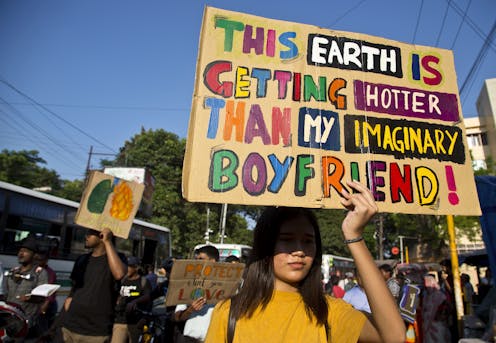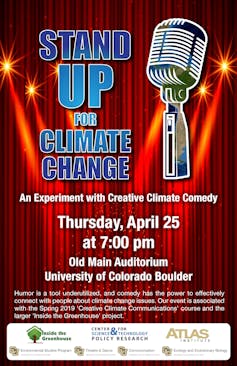Leave 'em laughing instead of crying: Climate humor can break down barriers and find common ground
'Two polar bears walk into a bar ...' is an unlikely opener for a joke, but memes and parodies are surprisingly effective ways to get people talking about climate change.

Climate change is not inherently funny. Typically, the messengers are serious scientists describing how rising greenhouse gas emissions are harming the planet on land and at sea, or assessing what role it played in the latest wildfire or hurricane.
Society may have reached a saturation point for such somber, gloomy and threatening science-centered discussions. This possibility is what inspires my recent work with colleague Beth Osnes to get messages out about climate change through comedy and humor.
I have studied and practiced climate communication for about 20 years. My new book, “Creative (Climate) Communications,” integrates social science and humanities research and practices to connect people more effectively through issues they care about. Rather than “dumbing down” science for the public, this is a “smartening up” approach that has been shown to bring people together around a highly divisive topic.
Why laugh about climate change?
Science is critically important to understanding the enormity of the climate challenge and how it connects with other problems like disasters, food security, local air quality and migration. But stories that emanate from scientific ways of knowing have failed to significantly engage and activate large audiences.
Largely gloomy approaches and interpretations typically stifle audiences rather than inspiring them to take action. For example, novelist Jonathan Franzen recently published an essay in The New Yorker titled “What If We Stop Pretending?” in which he asserted:
“The goal (of halting climate change) has been clear for thirty years, and despite earnest efforts we’ve made essentially no progress toward reaching it.”
Social science and humanities research have shown that this kind of framing effectively disempowers readers who could be activated and moved by a smarter approach.
Comics took a different path when the Intergovernmental Panel on Climate Change released a report in 2018 warning that the world only had until about 2030 to take steps that could limit warming to manageable levels. Trevor Noah, host of Comedy Central’s “The Daily Show,” observed:
“You know the crazy people you see in the streets shouting that the world is ending? Turns out, they’re all actually climate scientists.”
On ABC’s “Jimmy Kimmel Live,” Kimmel commented:
“There’s always a silver lining. One planet’s calamity is another planet’s shop-portunity.”
He then cut to a going-out-of-business advertisement for Planet Earth that read:
“Everything must go! 50% of all nocturnal animals, insects, reptiles and amphibians … priced to sell before we live in hell. But you must act fast because planet Earth is over soon. And when it’s gone, it’s gone.”
It’s getting hot in here
Social science and humanities scholars have been examining new, potentially more effective ways to communicate about climate change. Consistently, as I describe in my book, research shows that emotional, tactile, visceral and experiential communication meets people where they are. These methods arouse action and engagement.
Scholars have examined how shows like “Saturday Night Live,” “Last Week Tonight,” “Jimmy Kimmel Live,” “Full Frontal” and “The Daily Show” use jokes to increase understanding and engagement. In one example, former Vice President Al Gore appeared on “The Late Show with Stephen Colbert” in 2017 and took turns with Colbert serving up climate change pickup lines over saucy slow-jam background music:
Gore: “Are you climate change? Because when I look at you, the world disappears.”
Colbert: “I’m like 97% of scientists, and I can’t deny … it’s getting hot in here.”
Colbert: “Is that an iceberg the size of Delaware breaking off the Antarctic ice shelf, or are you just happy to see me?”
Gore: “I hope you’re not powered by fossil fuels, because you’ve been running through my mind all day.”
Comedian Sarah Silverman took time during her 2018 Hulu show “I Love You America” to address the need for climate action. In her monologue, she focused on how climate change is driven “by the interests of a very small group and absurdly rich and powerful people.” She added:
“The disgusting irony of all of it is that the billionaires who have created this global atrocity are going to be the ones to survive it. They are going to be fine while we all cook to death in a planet-sized hot car.”
Breaching barriers and finding common ground
Research shows that in a time of deep polarization, comedy can lower defenses. It temporarily suspends social rules and connects people with ideas and new ways of thinking or acting.
Comedy exploits cracks in arguments. It wiggles in, pokes, prods and draws attention to the incongruous, hypocritical, false and pretentious. It can make the complex dimensions of climate change seem more accessible and its challenges seem more manageable.

Many disciplines can inform comedy, including theater, performance and media studies. With my colleagues Beth Osnes, Rebecca Safran and Phaedra Pezzullo at the University of Colorado, I co-direct the Inside the Greenhouse initiative, which uses insights from creative fields to develop effective climate communication strategies.
For four years we have directed “Stand Up for Climate Change,” a comedy project. We and our students write sketch comedy routines and perform them in front of live audiences on the Boulder campus. From those experiences, we have studied the content of the performances and how the performers and audience respond. Our work has found that humor provides effective pathways to greater awareness, learning, sharing of feelings, conversations and inspiration for performers and audiences alike.
A comic approach might seem to trivialize climate change, which has life-and-death implications for millions of people, especially the world’s poorest and most vulnerable residents. But a greater risk would be for people to stop talking about the problem entirely, and miss the chance to reimagine and actively engage in their collective futures.
[ Like what you’ve read? Want more? Sign up for The Conversation’s daily newsletter. ]
Maxwell Boykoff receives funding from private donors to support Inside the Greenhouse activities at the University of Colorado.
Read These Next
Black-market oil buyers will push Venezuela for bigger discounts following US seizure – starving Mad
Venezuela relies on the black-market oil trade for a large chunk of its revenue. US enforcement actions…
As a former federal judge, I’m concerned by a year of challenges to the US justice system
A university president who’s a former federal judge looks at the rule of law and the Trump administration’s…
Songbirds swap colorful plumage genes across species lines among their evolutionary neighbors
Interbreeding across species lines is one way helpful genes can spread into a bird population.





